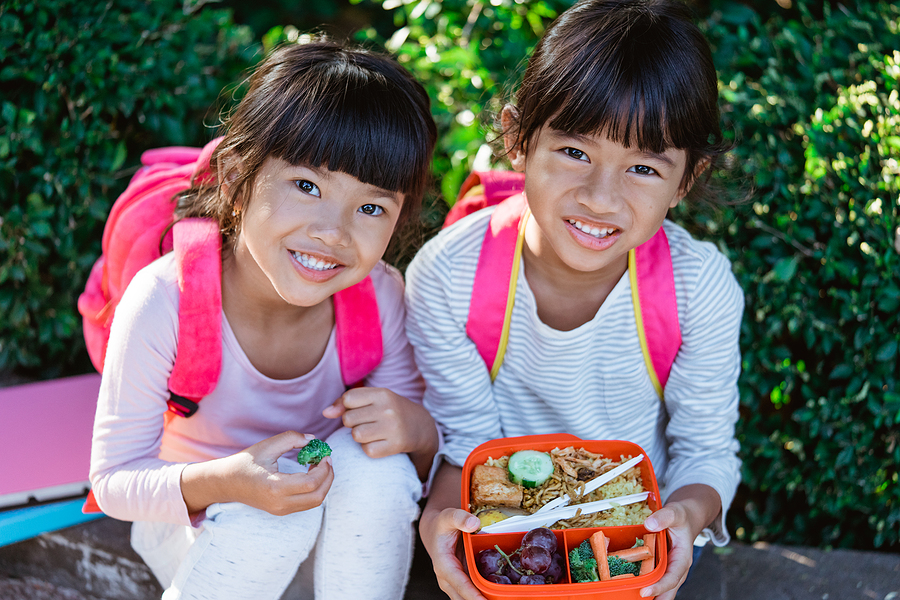
It's that time of year…back to school and preparing school lunches! Don’t worry, we’ve got you covered with the top dietitian recommended tips for preparing nutritious lunches that your kids will love with examples included.
Dietitian tips for preparing school lunches:
Tip # 1: Plan ahead
Planning saves time and stress. Take a few minutes before you go food shopping to list out the week’s lunches. Better yet, get your kids involved in making some decisions, like which fruit to pack. Find out more planning tips in our 7 steps for quick and easy meal planning article.
Tip # 2: Involve your kids
Getting kids to help with choosing and preparing lunches increases the odds that they will eat and enjoy their food. It also teaches them valuable life skills! Check out our article on cooking with kids for age-specific ideas to get kids involved in the kitchen.
Tip # 3: Keep it simple and balanced
Many kids don’t mind having the same type of lunch most days, so no need to overcomplicate it! A balanced lunch includes protein foods, whole grains, and fruits and vegetables. You can add variety by packing different types of fruit, alternating between whole grain bread and wraps, or adding in tasty additions like whole grain banana muffins.
Tip # 4: Don’t forget about food safety
Keeping food safe and at the right temperature is important when packing school lunches. Read this article for more information.
Is your child vegetarian? Do lunches often come back uneaten? Is your child a selective eater? Dietitians offer personalized advice to meet you and your family’s unique needs. Many dietitian services are covered through your employee benefits.
Nutritious and balanced lunch ideas
Lunch example #1:
A whole grain tortilla wrap with cheese, roasted turkey and baby spinach with a side of canned peaches, yogurt and water to drink.
|
Food or drink
|
Tips for choosing healthy ingredients
|
|
Tortilla wrap
|
-
Look for “whole grain” as the first ingredient such as “whole grain whole wheat flour”.
-
Choose grain products with 2 grams or more of fibre per serving. For a high fibre choice, look for 4 grams or more per serving.
|
|
Cheddar cheese
|
|
|
Roasted turkey meat
|
|
|
Baby spinach
|
|
|
Canned peach slices
|
|
|
Strawberry yogurt
|
|
|
Water
|
|
Lunch example #2
Bean chili with a side of cherry tomatoes with dip, an oatmeal cereal bar for dessert and milk to drink.
|
Food or drink
|
Tips for choosing healthy ingredients
|
|
Bean chili
|
-
Navy beans, kidney beans, white beans or lentils are nutritious plant-based protein choices.
-
Choose canned tomatoes or sauce that are lower in sodium or have no added salt.
|
|
Cherry tomatoes with dip
|
-
Choose low fat dip. Try tzatziki, hummus or salsa.
-
Try other vegetables like sliced cucumber, bell pepper rings, baby carrots, sugar snap peas, green beans or celery sticks.
|
|
Oatmeal cereal bar
|
|
|
Milk
|
|
Lunch example #3
Whole wheat pasta with Caesar salad, and smoothie to drink.
|
Food or drink
|
Tips for choosing healthy ingredients
|
|
Whole wheat pasta
|
-
Look for whole wheat or whole grain pasta.
-
Choose a sauce made with lower sodium canned tomatoes or sauce.
-
Add fresh vegetables such as onions, mushrooms and peppers for extra flavour, fibre and vitamins.
|
|
Side Caesar salad
|
-
Look for a salad dressing lower in saturated fat.
-
Instead of bacon bits, add roasted chicken breast (this is a great use for leftovers) or chickpeas for protein.
|
|
Smoothie
|
-
Blend up your child’s favourite frozen fruit with plain yogurt, milk or fortified plant-based beverage.
-
Using frozen fruit will help the smoothie stay cold and refreshing.
|
Lunch example #4
Steamed rice with tofu, bok choy and snow pea stir-fry, with a side of sliced mango, a small homemade whole grain muffin and water to drink.
|
Food or drink
|
Tips for choosing healthy ingredients
|
|
Steamed rice
|
|
|
Tofu
|
-
Canada’s Food Guide recommends eating more plant-based proteins, like tofu.
-
You can also make stir-fries with chicken, pork, beef, salmon, shrimp and scrambled egg.
|
|
Bok choy, snow peas
|
|
|
Mango slices
|
-
Orange coloured fruit such as mangoes have vitamin A. Other good choices are papaya, peaches, nectarines, cantaloupe and apricots (but not oranges).
|
|
Whole grain muffin
|
|
How can a dietitian help?
A dietitian will make sure your child is getting important nutrients like protein, fibre, iron and calcium that your child needs to grow and be healthy. Your dietitian will make suggestions on how to boost the nutrition of the foods they are already eating and give you a plan on how to introduce new ones. They can also help you plan balanced school lunches and help you with reading labels. Connect with a dietitian today!
Bottom line
A balanced lunch includes vegetables and fruits, whole grains and protein foods. Involve kids in planning and meal prep to increase the likelihood that they will eat their lunch.
You may also be interested in:
Family-Friendly One-Week Sample Menu Plan
Simple Lunch Solutions for your Kids
Make a Balanced Breakfast a Habit in Your Home
This article was written and reviewed by dietitians from Dietitians of Canada. The advice in this article is intended as general information and should not replace advice given by your dietitian or healthcare provider.
Last Update – February 6, 2023